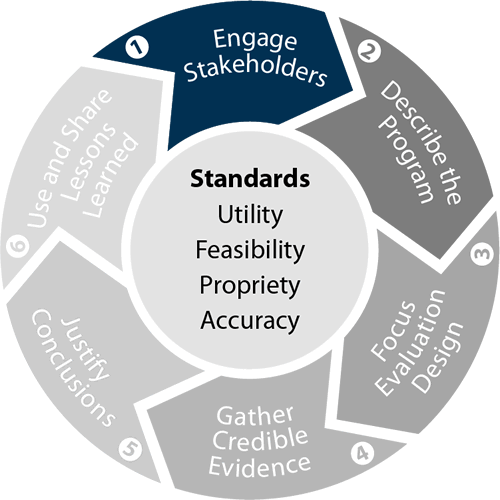Program Evaluation Framework Checklist for Step 1
Engage Stakeholders
Checklists for Each Step
- ›Step 1 Checklist: Engage Stakeholders
- Step 2 Checklist: Describe the Program
- Step 3 Checklist: Focus the Evaluation

The first step in the CDC Framework approach to program evaluation is to engage the stakeholders. Stakeholders are people or organizations that are invested in the program, are interested in the results of the evaluation, and/or have a stake in what will be done with the results of the evaluation. Representing their needs and interests throughout the process is fundamental to good program evaluation. A program may have just a few or many stakeholders, and each of those stakeholders may seek to be involved in some steps or all six steps. This checklist helps identify stakeholders and understand their involvement in the evaluation.
Although “Engaging Stakeholders” is the first of the 6 steps, the first three steps of the CDC Framework are iterative and can happen in any sequence. For instance, identifying the right stakeholders may make more sense to do for your evaluation after drafting the purpose, user, and use of the evaluation that happens in Step 3. That said, this checklist will help you think through the key points in identifying and engaging stakeholders throughout your evaluation.
Brainstorm potential stakeholders. These may include, among others:
- People affected by your program
- People involved in implementing the program or conducting the evaluation
- People who will use the results of the evaluation. These may include internal staff, partners, program participants, community members, and other organizations, among others
In brainstorming the list be sure to think broadly, including in your list:
- People in the above categories who share your priorities, and people who don’t
- People in the above categories who are critics as well as supporters
Especially if the list is very long, try to extract the subset of most important stakeholders. Some helpful criteria for identifying whether a person or organization is a key stakeholder include that they:
- Increase the credibility of your program or your evaluation
- Are responsible for day-to-day implementation of the program activities that are being evaluated and will need to implement any changes
- Can advocate for the changes to the program that the evaluation may recommend, OR actively oppose the recommended changes
- Fund or authorize the continuation or expansion of the program
Discuss with key stakeholders individually the best way to engage them—in person, phone, email etc. Regardless of chosen medium, in the engagement discussions get clarity on the following questions: [NOTE: If a preliminary logic model for the program has been completed, then use it to help frame and target the questions.]
- What do you see as the main outcomes of the program?
- What do you see as the main activities of the program?
- Which of the activities and outcomes are most important to you? That is, to retain your involvement and support, which activities must be effectively implemented and/or which outcomes achieved?
- What do you see as the most important evaluation questions at this time?
- [If outcomes are included] How rigorous must the design be?
- Do you have preferences regarding the types of data that are collected (e.g., quantitative, qualitative)?
- What resources (e.g., time, funds, evaluation expertise, access to respondents, and access to policymakers) might you contribute to this evaluation effort?
- In what parts or steps of this evaluation would you want to be involved? All or just some specific ones?
- How would you like to be kept apprised of this evaluation? How best to engage you in the steps in which you want to be involved?
- (How) will you use the results of this evaluation?
Examine the results of the stakeholder discussion for insights related to development/refinement of the program description and logic model. Also examine for a starter set of important evaluation questions, which will be elaborated during Step 3.
Especially if there are many stakeholders, summarize the results of the engagement discussions with a [simple or detailed as you prefer] plan for stakeholder involvement, including which stakeholders will participate/provide input during the major stages of the project and what their roles and responsibilities will be for each step.
E-mail: cdceval@cdc.gov